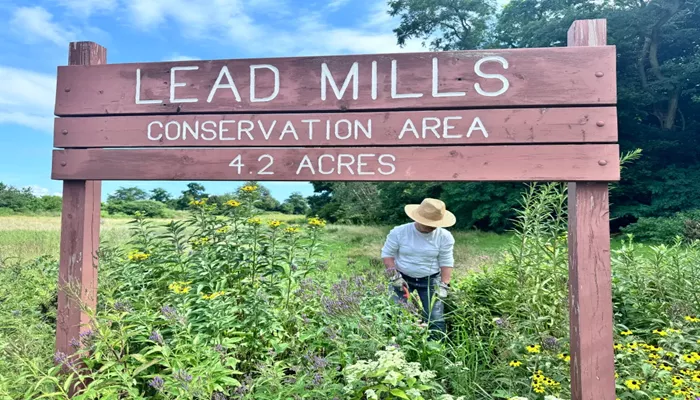On a sunny morning at Lead Mills, a former industrial site transformed into a conservation area, volunteers Mary Krull and Patricia Hines are busy tending to a patch of wildflowers. Their efforts are part of a growing movement in Marblehead to create landscapes that support pollinators using native plants.
This initiative at Lead Mills exemplifies a broader commitment to enhancing local ecosystems and supporting the crucial pollinators that sustain them. According to Mass Audubon, pollinators are organisms that transfer pollen between flowers, a vital process for plant reproduction and fruit production.
In Marblehead, the push for native plants has gained momentum, driven by environmental concerns and increasing awareness of the threats faced by pollinator populations. Susan Fitzgerald, a horticulture specialist at Marblehead Garden Center, noted, “We’re seeing bees disappear. They used to be everywhere, but now you can only find them around native plants.”
Native plants have evolved alongside local pollinators and are especially effective at attracting and supporting these insects. Common native plants in Marblehead include asters, goldenrod, and milkweed.
The Lead Mills project aims to create not only a vibrant display for visitors but also a haven for pollinators. The area will feature milkweed for monarch butterflies, goldenrod for ladybugs and moths, and golden Alexander for sweat bees. This variety of plants will provide sustenance for various pollinators, including beetles, birds, bees, and butterflies, throughout the growing season.
Hines highlighted the unique beauty of native plant gardens, saying, “It’s not your typical garden, but it is extraordinary. It connects you more to nature and brings you back to the earth.”
The Lead Mills initiative is led by the Marblehead Conservancy and is based on research from the Gegear Lab at UMass Dartmouth. This research focuses on supporting specific bumblebee species whose populations have dramatically declined in recent decades. Krull explained, “Some bumblebee populations are stable, while others have plummeted to just 5% of their numbers from 20 years ago. This is largely because their food sources are disappearing.”
The Driftwood Garden Club, a local organization with over 60 years of community service, is also embracing this trend. Kathy Bradford, co-chair of the club’s conservation working group, discussed their efforts at the Abbot Public Library. “We’re adapting to the times,” she said. “With climate change, the plants we choose will be drought-tolerant.” This September, the club plans to install native perennials in the library’s courtyard to attract butterflies and hummingbirds. Bradford hopes to add educational signs to help visitors identify the plants and understand their importance.
At Devereux School, a pollinator garden serves as a refuge for insects and an outdoor classroom. Fourth and fifth-grade teacher Kasey Sampson uses the garden to teach students about local ecology and history. “I teach the kids about the herbs and their historical uses,” she said, pointing out a patch of goldenrod known for its medicinal properties. “Goldenrod helps with seasonal allergies and sinus congestion. It was used by colonists after the Boston Tea Party.”
The garden, which includes milkweed, bee balm, asters, and goldenrod, was initially planted by parent volunteer Suzanne Hale and has since been certified as a monarch butterfly garden. “The kids love looking for butterfly eggs on the milkweed,” Sampson noted. “It supports the monarchs’ entire life cycle.”
Monarch butterflies depend on milkweed for laying eggs and feeding their caterpillars, underscoring the importance of preserving native plant species.
This trend toward native plantings extends beyond public spaces. Many homeowners are reconsidering their landscaping choices, opting for pollinator-friendly gardens instead of traditional lawns and ornamental plants. Fitzgerald has seen an increasing demand for native plants at the garden center, with customers specifically seeking pollinator-friendly options. “People are willing to replace evergreens or summer-flowering shrubs with plants that attract pollinators,” she said.
This shift in gardening practices goes beyond aesthetics. Fitzgerald emphasized the crucial role of pollinators in food production: “Anyone who enjoys eating relies on pollinators. They are essential for the growth of fruits and vegetables.”
Indeed, pollinators are vital for the reproduction of many crops. Mass Audubon reports that primarily bees pollinate most of the fruits and vegetables used in agriculture. However, pollinator populations are facing numerous threats, including habitat loss, pesticide use, and climate change. Mass Audubon has found that populations of three bumblebee species in the eastern United States have declined by over 90% in the past 30 years.
In response to these challenges, local environmental groups are taking action. Sustainable Marblehead, a grassroots organization promoting environmental sustainability, advocates for native plantings and pollinator-friendly practices. Co-chair Evans Slepian emphasized the interconnectedness of ecosystems and human well-being. “We are nature,” Slepian stated. “It’s a narrow viewpoint to see ourselves as separate from nature. We are all impacted by these changes.”


